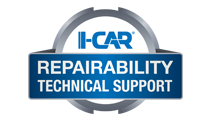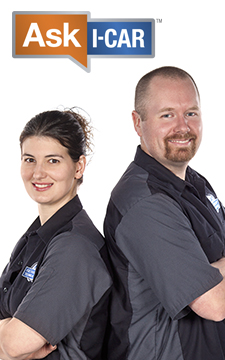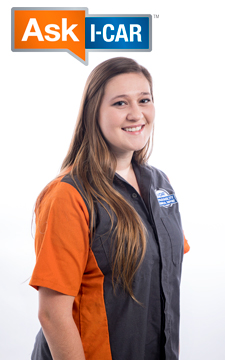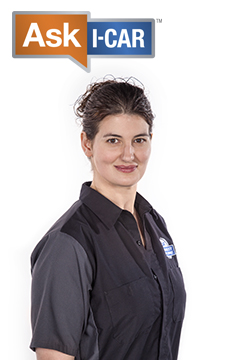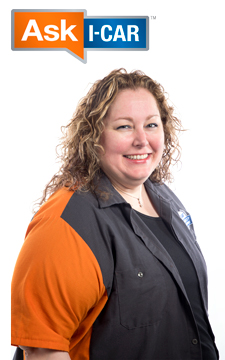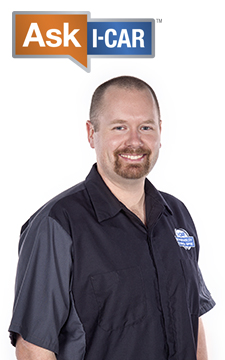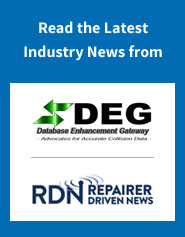Collision Repair Diagnostics - The Next Essential Collision Repair Process
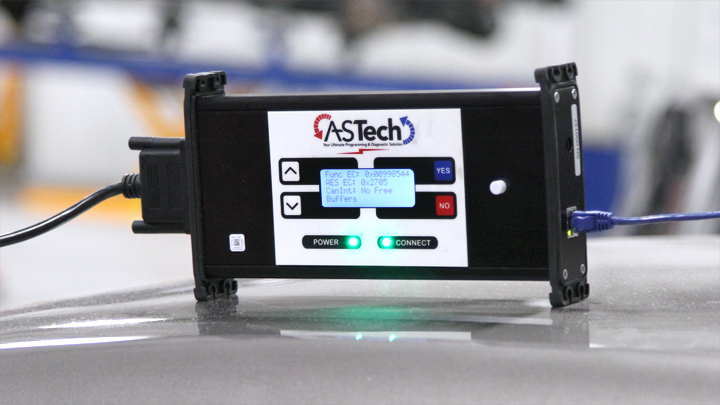
Article originally appeared in Repairer Driven News on December 17, 2015
By Steve Marks
Would you ever attempt to repair a late-model collision-damaged vehicle without three-dimensional measuring? Of course you wouldn’t. Without measuring, it isn’t possible to determine the extent of damage, or to identify hidden damage – which can impact the safety of drivers and passengers in future accidents.
Yet, every day, many vehicles are returned to owners with hidden damage because according to technicians, “There isn’t a warning lamp illuminated on the dash.”
Without a diagnostic check, there isn’t a way to identify hidden damage to today’s advanced vehicle electronics and driver assistance systems. Especially since there are a significant number of systems that don’t provide a visual indication that there is a system malfunction or history code of some type.
While tools such as self-piercing rivet (SPR) guns and MIG brazing equipment may be new to many of us, scan tools have been available for many years, but few of us have embraced them for collision repairs. To ensure complete, safe, and quality repairs, while improving cycle time, improving CSI, and reducing comebacks, it may be time to take a close look at scan tools; and the incorporation of collision repair diagnostics in your collision repair process.
Vehicle Systems
The need for scan tools isn’t new to technicians; we’ve had to leverage them for years to identify fault codes and turn off malfunction indicator lamps (MIL) for airbags, antilock brakes, and traction control systems. However, a lot of that work was sublet to a dealership, or a service provider that specialized in this type of work.
Restraints systems, antilock braking systems (ABS), and traction control systems (TCS) also provided a clear indicator that there was a code that needed to be cleared. With many of today’s advanced vehicle safety and driver assistance systems, that isn’t the case.
More frequently, today’s vehicles are being equipped with collision mitigation technologies: Lane keep assist/lane departure warning, collision warning, adaptive cruise control, 360-degree camera views, and blind-spot warning systems. Many of these vehicle systems require “zero-point calibration” following replacement of system parts.
The majority of the zero-point calibration procedures call for the use of a scan tool. And, oftentimes, it goes beyond just hooking the scan tool up to the vehicle; it may involve driving the vehicle, or other special parameters, such as where the vehicle has to be located for the procedure to work.
A few months ago, the I-CAR Repairability Technical Support team developed video segments to show examples of zero-point calibration requirements on a 2015 Ford F-150. Ford Motor Company offers this vehicle with a number of advanced safety and driver assistance options. Many of these systems require calibration/initialization following part removal and/or replacement.
For example, in the past, replacing a side mirror on a vehicle was a straightforward process: Remove the damaged mirror and install the new mirror. With Ford’s 360-degree camera option, this is no longer the case. Even if nothing other than the mirror is damaged, a scan tool is required to properly repair the vehicle.
With the 360-degree camera, special calibration mats are required for alignment and the vehicle must be parked “in a flat open area…with a minimum of 6 feet of open space to each side, 7 feet of open space in front, and 11 feet of open space behind the vehicle.”
Additionally, the “area where the alignment is performed must be free of shadows and glare.” However, it’s not quite as simple as just placing the vehicle in the proper location and putting the mats down on the floor next to the vehicle. There are also very specific requirements for where the mats must be placed in order for the diagnostic alignment process to accurately take place. Improperly placing the mats will have an adverse effect on camera system performance.
Once the mats are properly located, following the calculations provided in the service manual, the alignment procedure could begin. The next steps are guided by the scan tool, but if the alignment procedure is unsuccessful, there are several pages of faults that require additional investigation. Keep in mind, all of this is required for just a side mirror equipped with the 360-degree camera option.
Remember, because no two vehicles have the same procedures, OEM service information, coupled with a scan tool, is required every time to do a complete, safe and quality repair.
Diagnostics required?
When are diagnostics required? Unfortunately, this question doesn’t have a simple answer. It will often be based on the age of the vehicle, the type and extent of damage, which options the vehicle is equipped with and their component locations.
Collision repair professionals will have to apply a level of sound judgment to each vehicle that requires repairs; a scratch in the bumper cover of a late model vehicle may not need diagnostic work performed (depending on what’s required to repair the bumper cover), but a frontal collision with multiple airbag deployments likely will.
It is important to note that many vehicle makers require calibration/initialization of advanced safety, and driver assistance, systems following part replacement, regardless of the extent of damage. If the repairs being performed include the replacement of sensors, wires, computers, etc. the OEM service information should be referenced to identify if calibration/initialization is required.
To concretely determine if a scan tool is required, you’re going to first need to identify which advanced safety or driver convenience systems, if any, the vehicle is equipped with. If parts of those systems require replacement (or R&I), you’ll then have to consult the vehicle maker service information.
This part of the process can be a bit challenging. Service manuals aren’t designed for collision repairs; they’re designed for system faults that often result in the customer bringing their vehicle back to the dealership. From my experience, they’re not laid out as intuitively as many of the collision repair manuals are today.
However, with practice, you’ll learn how to best navigate within each OEM’s service information. Once you find the replacement procedure for the sensor, computer, etc. required for your particular repair, there will usually be a link to the calibration procedure. Once you’ve read through the procedures, you’ll know if a scan tool is required and if there are any additional special considerations for calibration.
Tool options
Once you’ve decided to train an employee – or hire one – to be your lead collision repair diagnostic technician, you’re going to need to determine which tool(s) you’re going to leverage. Similar to other pieces of equipment you’ve invested in, you’re going to want to do thorough research to determine which type of equipment is best for you. Again, similar to other tools and equipment, you’ll see that each type has features that work great for you and each has limitations that you’ll need to consider.
Option 1: OEM scan tools work great if you’re primarily working on one or two model lineups. OEM scan tools will offer more in-depth coverage than non-OEM scan tools, but won’t offer you as broad of a range of vehicles.
However, if you don’t often work on multiple makes, you’d still be able to sublet those vehicles to a local dealership. If you want to stick solely to OEM scan tools and have coverage across a large range of vehicle makes, be prepared to make a heavy financial investment.
Option 2: Aftermarket scan tools offer the flexibility to work on a wide range of makes and models, but don’t always offer the depth that OEM scan tools do. These tools are designed to work on OBD-II systems, along with systems that may be more prone to a failure. You’ll want to thoroughly investigate which makes, models, and years these systems will provide coverage for.
I believe you’ll see a lot more aftermarket scan tools designed for collision repair professionals in the next couple of years as I-CAR continues to work with the Equipment and Tool Institute (ETI) to demonstrate the opportunities in the collision repair industry for many of these system calibration requirements.
Option 3: Option 3 isn’t a scan tool – it’s a tool that “talks to” scan tools from Collision Diagnostic Services, which recently unveiled their asTech2. With this tool, which is currently the only one of its kind on the market designed for the collision repair industry, you have access to OEM scan tools through the service that CDS offers.
To leverage the CDS service, a technician connects the asTech2 to the vehicle, via the OBD II port. Next, the asTech2 is connected to the Internet via an Ethernet cable, or Wi-Fi. The technician then goes online to the asTech2 website and submits a service request. A CDS staff member then scans the vehicle, remotely, using an OEM scan tool. After scanning the vehicle, CDS submits a full report to the collision repair facility identifying each, if any, of the fault codes the vehicle has.
Diagnostics and the workflow?
If you’ve incorporated an otherwise robust blueprinting practice into the damage analysis process, you may want to add collision repair diagnostics into that process.
Checking for diagnostic trouble codes (DTCs) during blueprinting may help to avoid “time bandits” (supplements, last-minute sublets, etc.) later in the process. Checking for stored codes can also identify faults or issues that were pre-existing, possibly having nothing to do with the damage currently being evaluated, but will need to be addressed to provide a safe and complete repair, or at least disclosed so the vehicle owner is aware of the vehicle condition.
By identifying faults early in the process, you’ll be better prepared to deliver on-time, with all repairs completed. Coupled with considering incorporating a diagnostic check into your post-repair inspection process to ensure that nothing was missed, you’ll be able to share documentation with your customer and ultimately help improve cycle time, CSI and fewer comebacks.
Complete, safe, and quality repairs – a leading reason to consider incorporating more collision repair diagnostics into your daily collision repair activities.
Additional I-CAR Collision Repair News you may find helpful:
Related I-CAR Courses
Article validated in 2025
-
Toyota/Lexus/Scion Position Statement: Pre- and Post-Repair System Scanning
Thursday, 28 July 2016
As the industry continues to ask if pre- and post-repair system scanning is necessary, Toyota/Lexus/Scion provides their answer.
-
Pre- and Post-Repair System Scanning Statements
Wednesday, 9 January 2019
Are you wondering if a particular OEM or organization has a published statement on pre-repair and post-repair scanning? We have compiled a list of most of the statements on the subject, so you can...
-
ADAS, Calibration, And Scanning Article Hotspot
Monday, 14 January 2019
Since advanced driver assistance systems (ADAS), scanning, and calibration first started becoming relevant, members of the collision repair industry have required as much knowledge as possible on...
-
Honda/Acura Position Statement: Pre- and Post-Repair System Scanning - UPDATE
Wednesday, 22 May 2019
Honda /Acura has updated their position statement on pre- and post-repair scanning to give more clarification on what is expected for scanning.
-
BMW Position Statement: Pre- and Post-Repair System Scanning - UPDATE
Friday, 10 April 2020
BMW has released a position statement related to pre- and post-repair system scanning. The statement applies to All vehicles equipped with on board diagnostics II (OBD II).
-
Quickly Identifying Outer Quarter Panels w/Rolled Hem Flanges
Monday, 5 March 2018
The I-CAR best practice article, Recycled Outer Quarter Panels w/Rolled Hem Flanges has gotten a lot of interest from the collision repair industry. It’s important to know which vehicles are...
-
General Motors Position Statement: Pre- and Post-Repair System Scanning
Friday, 21 October 2016
As the industry continues to ask, are pre- and post-repair scans necessary, General Motors provides their answer.
-
Restraints Wiring Repairs
Monday, 23 May 2016
Over the past few months, we've been sharing OEM position statements on restraints wiring repairs. Now we're bringing them all together in one place for easy reference.
-
FCA/Stellantis Position Statement: Pre- and Post-Repair System Scanning
Thursday, 9 June 2016
FCA/Stellantis has released a position statement related to pre- and post-repair system scanning.
-
Typical Calibration Requirements For Forward Radar Sensors
Wednesday, 12 October 2016
Technicians should be aware of what’s required to keep advanced driver assistance systems (ADAS) running safely after a collision. Whether that be aiming a camera, which can cause a system to not...
-
App-Based Connected Services Considerations: BMW
Wednesday, 10 December 2025
Have you had an experience where the vehicle notified the owner that it was being moved while it was in your repair facility? App-based connected services are available from many vehicle makers and...
-
Digital Key Considerations: BMW
Wednesday, 10 December 2025
The intermingling of technology and automobiles continues, with digital key offerings from most vehicle makers. Digital keys utilize smartphone technology to expand vehicle access and owner...
-
I-CAR Repairers Realm: RTS 2025 Year In Review - Coming Soon
Tuesday, 9 December 2025
I-CAR is having a discussion on the Repairability Technical Support (RTS) 2025 year in review.
-
Mercedes-Benz Vehicles On The RTS OEM Calibration Requirements Search
Thursday, 4 December 2025
Mercedes-Benz models are now listed in the OEM Calibration Requirements Search page on the RTS website. You're going to notice a difference between other vehicle search results and Mercedes-Benz...
-
I-CAR Repairers Realm - New In 2026: Mixed Attachment Methods And Steel Sectioning Recertification - Now Available
Monday, 1 December 2025
I-CAR had a discussion on the new Mixed Attachment Methods course launching in 2026.
-
Repairer Driven News: SCRS OEM Collision Repair Technology Summit Sessions
Monday, 1 December 2025
Repairer Driven News published three articles highlighting safety inspection topics that took place during the Collision Repair Specialists (SCRS) OEM Collision Repair Technology Summit at the 2025...
-
I-CAR Audi Collision Repair And Electromechanical Repair Overview Courses
Tuesday, 25 November 2025
I-CAR has developed courses that provide an overview of collision repair and electromechanical repair for current Audi vehicles.
-
SEMA 2025: Ford/Lincoln Presentations
Monday, 24 November 2025
I-CAR had numerous presentations at the 2025 SEMA show. Ford/Lincoln delivered two presentations.
-
Honda/Acura Rear View And 360 View Cameras - UPDATE
Friday, 21 November 2025
While searching for information on advanced driver assistance systems (ADAS) on an OEM repair information site, you may come across unique calibration procedures or events. These events can vary by...
-
Ford/Lincoln Position Statement: OEM Structural Fasteners And Adhesives - UPDATE
Thursday, 20 November 2025
Ford/Lincoln has released a position statement about the use of OEM structural fasteners and adhesives.
- 2025
- December 2025 (6)
- November 2025 (12)
- October 2025 (13)
- September 2025 (11)
- August 2025 (12)
- July 2025 (11)
- June 2025 (11)
- May 2025 (11)
- April 2025 (13)
- March 2025 (12)
- February 2025 (11)
- January 2025 (12)
- 2024
- December 2024 (8)
- November 2024 (10)
- October 2024 (13)
- September 2024 (10)
- August 2024 (12)
- July 2024 (11)
- June 2024 (9)
- May 2024 (13)
- April 2024 (12)
- March 2024 (12)
- February 2024 (12)
- January 2024 (9)
- 2023
- December 2023 (8)
- November 2023 (12)
- October 2023 (11)
- September 2023 (11)
- August 2023 (12)
- July 2023 (9)
- June 2023 (11)
- May 2023 (12)
- April 2023 (11)
- March 2023 (12)
- February 2023 (10)
- January 2023 (11)
- 2022
- December 2022 (11)
- November 2022 (12)
- October 2022 (11)
- September 2022 (13)
- August 2022 (11)
- July 2022 (10)
- June 2022 (13)
- May 2022 (11)
- April 2022 (12)
- March 2022 (10)
- February 2022 (11)
- January 2022 (13)
- 2021
- December 2021 (13)
- November 2021 (11)
- October 2021 (13)
- September 2021 (14)
- August 2021 (12)
- July 2021 (15)
- June 2021 (17)
- May 2021 (12)
- April 2021 (14)
- March 2021 (20)
- February 2021 (14)
- January 2021 (14)
- 2020
- December 2020 (13)
- November 2020 (17)
- October 2020 (12)
- September 2020 (14)
- August 2020 (11)
- July 2020 (18)
- June 2020 (14)
- May 2020 (14)
- April 2020 (19)
- March 2020 (12)
- February 2020 (13)
- January 2020 (14)
- 2019
- December 2019 (13)
- November 2019 (19)
- October 2019 (25)
- September 2019 (20)
- August 2019 (22)
- July 2019 (23)
- June 2019 (20)
- May 2019 (19)
- April 2019 (20)
- March 2019 (20)
- February 2019 (18)
- January 2019 (17)
- 2018
- December 2018 (18)
- November 2018 (19)
- October 2018 (17)
- September 2018 (16)
- August 2018 (21)
- July 2018 (20)
- June 2018 (21)
- May 2018 (17)
- April 2018 (19)
- March 2018 (21)
- February 2018 (15)
- January 2018 (20)
- 2017
- December 2017 (13)
- November 2017 (15)
- October 2017 (19)
- September 2017 (20)
- August 2017 (19)
- July 2017 (18)
- June 2017 (19)
- May 2017 (19)
- April 2017 (13)
- March 2017 (18)
- February 2017 (10)
- January 2017 (11)
- 2016
- December 2016 (9)
- November 2016 (14)
- October 2016 (21)
- September 2016 (10)
- August 2016 (11)
- July 2016 (8)
- June 2016 (10)
- May 2016 (5)
- April 2016 (11)
- March 2016 (12)
- February 2016 (10)
- January 2016 (8)
- 2015
- December 2015 (9)
- November 2015 (6)
- October 2015 (8)
- September 2015 (7)
- August 2015 (11)
- July 2015 (7)
- June 2015 (5)
- May 2015 (7)
- April 2015 (8)
- March 2015 (8)
- February 2015 (9)
- January 2015 (10)
- 2014
- December 2014 (12)
- November 2014 (7)
- October 2014 (11)
- September 2014 (10)
- August 2014 (9)
- July 2014 (12)
- June 2014 (9)
- May 2014 (12)
- April 2014 (9)
- March 2014 (6)
- February 2014 (1)
- January 2014 (26)
